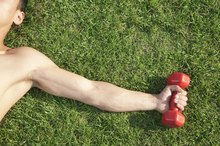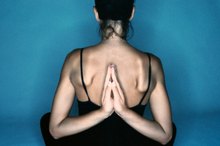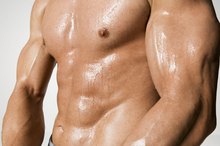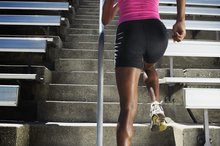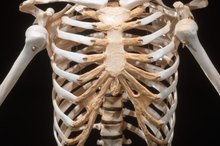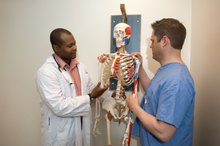Muscles That Control the Human Hand
The human hand is a picture of complexity and balance. The muscles that control the hand allow it to be strong and refined. Muscles that influence hand movement either originate on bones outside or inside the hand. Muscles that originate outside the hand are referred to as extrinsic; those originating inside the hand are termed intrinsic. Many extrinsic hand muscles also influence movement at the wrist as well as the hand. The dexterity of the hand is due to a combination of these muscles, as well as ligaments, bones and joint capsules.
Extrinsic Finger Flexors
There are two main extrinsic muscles that flex or bend the fingers into the hand, as if making a fist. The flexor digitorum superficialis (FDS) begins at the elbow, and has tendons that insert on all fingers except for the thumb. Activation of the FDS flexes the fingers at the first two joints. The flexor digitorum profundus (FDP) originates from the ulna just below the elbow, and inserts on all fingers except the thumb. Activation of the FDP flexes the fingers at all joints. If these muscles are not countered with an extensor force, wrist flexion also results.
- There are two main extrinsic muscles that flex or bend the fingers into the hand, as if making a fist.
- The flexor digitorum superficialis (FDS) begins at the elbow, and has tendons that insert on all fingers except for the thumb.
Extrinsic Finger Extensors
What Are the Names of the Muscles in the Arm & Shoulder?
Learn More
There are three muscles that act to extend or straighten the fingers. The extensor digitorum arises from the end of the humerus (upper arm bone), goes to all fingers except the thumb, and extends them when contracted. The extensor digitorum is also a strong wrist extensor. The extensor indicies is a shorter muscle originated just before the wrist, and only extends the index finger. The extensor digiti minimi is similar, only its main purpose is to extend the little finger. These muscles use an elaborate mechanism made up of tendons and ligaments to influence control of the fingers.
- There are three muscles that act to extend or straighten the fingers.
- The extensor indicies is a shorter muscle originated just before the wrist, and only extends the index finger.
Hand Intrinsics
The interossei muscles are found on the palmar and dorsal (back of hand) aspects of the hand. Dorsal interossei act to abduct or spread the fingers apart from the middle finger. The palmar interossei act to adduct or bring the fingers back toward the middle finger. Both sets of interossei muscles insert on the extensor mechanism. The lumbricals are the other set of hand intrinsics. These muscles allow you to flex your fingers at the first knuckle while keeping the others straight.
- The interossei muscles are found on the palmar and dorsal (back of hand) aspects of the hand.
- The palmar interossei act to adduct or bring the fingers back toward the middle finger.
Thumb Muscles
List of Muscles Attached to Major Bones of Body
Learn More
The thumb moves differently from the other fingers due to its unique bone structure and dedicated set of muscles. These muscles allow you to use your thumb independently and make it able to oppose the position of the fingers. However, like the fingers, there are intrinsic and extrinsic thumb muscles. Extrinsic thumb muscles are the flexor pollicis longus, extensor pollicis longus and brevis, and the abductor pollicis longus. The intrinsic thumb muscles are located in the thenar eminence, the meaty portion of your hand between your thumb and wrist. These muscles include the opponens pollicis, abductor pollicis brevis, flexor pollicis brevis and adductor pollicis.
- The thumb moves differently from the other fingers due to its unique bone structure and dedicated set of muscles.
- The intrinsic thumb muscles are located in the thenar eminence, the meaty portion of your hand between your thumb and wrist.
Related Articles
References
- Levangie P, Norkin C. Joint structure and function: A comprehensive analysis. 4th ed. Philadelphia: The F.A. Davis Company; 2005.
Writer Bio
Tyler Shultz is a third-year doctor of physical therapy student at the Medical College of Georgia in Augusta, Ga. His articles have appeared in numerous physical therapy blogs since 2009, including PT ThinkTank and AAOMPT-sSIG blog. Tyler graduated from the University of Georgia with a Bachelor of Science in health promotion in 2007.
